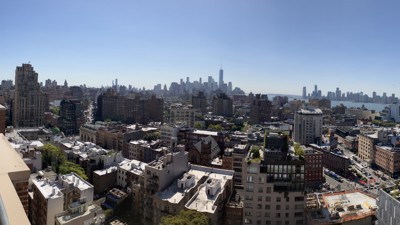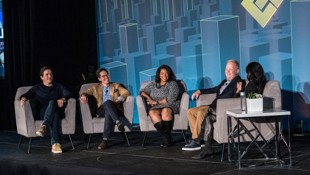Earlier this month the GPE Innovation team spent a really useful few days in New York, primarily to attend the CRETech Conference but also to meet innovators in other real estate companies, tech firms, advisors and customers to better understand emerging trends and to help GPE to continue to drive innovation.
Before leaving for New York, I wasn’t sure what to expect, a lot has been written about how it is struggling to return after the pandemic – yet I found lots of energy, ideas and innovation that make New York famous. Yes there is a lot of poor quality office stock, some evidence of entrenched views of landlord and tenant relationships, but mostly I found a sense that a lot of people are working hard to address these issues. Above all else though I found the sense of willingness to confront problems and try to find new solutions, my key takeaways were:
- US Real Estate companies and big tech are making serious commitments to sustainability;
- Large enterprise customers are making serious effort to make hybrid working work;
- Traditional landlords are starting to have to respond to this customer changing need;
- The market has matured in the implementation of PropTech and use of data;
- New York is investing in some fantastic public realm
- Landlords and business are starting to take the metaverse seriously
1. Sustainability
Both Ella and I were pleasantly surprised by the number of large real estate companies making some big commitments and investments in helping to achieve net zero. The conversation seems to have moved on from ‘who is paying for these improvements’ to the acceptance that it is ‘simply good business’ to reduce your operational energy. This is driving significant investment in IoT, Smart Buildings, platforms and sensors – but also how you can use this data to help reduce consumption. Google have moved their Sidewalk Labs team (it is still very much alive) into their Sustainability efforts – their own platforms like Delve and Mesa are there to combine big data with lowering our carbon footprint.
World famous architects like BIG with their platform NABR and SHoP with their own platform Assembly are also making investment into modular assembly and Proptech themselves – trying to find ways to reduce material consumption and improve costs. Both NABR and Assembly have both achieved Series A funding with big plans for growth. Other young sustainability related start-ups like Tangible Materials have been inspired by our Janine Cole whilst working in Europe. US companies feel a couple of years behind Europe and the rest of the world – but there is hope that they will come together.
2. Getting to Grips with Hybrid
Companies everywhere are struggling with hybrid working and what it means for their own staff – Deloitte have formed a new practice in Human Capital based on advice on how to work in the physical, digital (Teams, Zoom etc) and virtual worlds (Horizon etc) – and are advising a wide range of firms on how to make this work. The US faces greater challenges in terms of headcount – the population dispersed, there are tangible tax benefits to being in different states and unemployment remains low. As a result this is driving more innovation in how and where people work and investment is being made in workplaces all over the city. Accenture’s offices in Hudson Yards were a great example of a space that brings their customers and staff together to see and work around leading pieces of innovation. There is a long way to go, and with office vacancy in some areas as high as 20%, a lot of reinvention to do – but I encountered a real willingness to embrace the opportunity.
3. Landlords starting to embrace their tenants
We started to see evidence of some landlords starting to take their customers’ needs seriously – but nowhere on scale of our own Customer first approach – a root and branch philosophy to change our operating model. We did see a number of spaces starting to shift; many examples of softer reception areas, great use of music in lobbies, security guards in relaxed uniforms and trying to get to grips with more amenity in spaces. For example, at the Rockefeller Centre Tishman Speyer have continued with their Studio concept to provide better public realm, technology and spaces to collaborate outside of the workplace. Customers are starting to get to grips with how they access all of this, it’s a start and there is a long way to go.
4. Maturing PropTech and Data
We found plenty of evidence of growing maturity in both the use of and investment in PropTech, in particular JLL and CBRE are both making huge investments in order to maintain their place as key property advisors. CBRE’s recent investment in VTS and their RISE platform (a workplace app like our own sesame) as well as JLL Spark investment in HqO and Swift Connect means that globally workplace apps will find it easier to gain traction in workplaces as contactless access becomes a reality.
Large funds like Starwood, PGIM, Hines, Silverstein and others all advocated the use of Software as a Service (SaaS) products, but all agreed that building your own data warehouse and dashboards to control this data was the secret sauce. Whilst they are all set up in a different way, they have similar resources and structures to innovation. They are likely to split their teams into three focus areas; future proofing, implementing innovation and managing data. An approach that we too have been using at GPE. This is helping real estate companies to start to understand more about their portfolios and increasingly in terms of sustainability.
5. New York and Public Realm
One of the major success stories over the past decade has undoubtedly been the High Line – the reuse of derelict railway tracks has regenerated and attracted people to the west side of New York around the Meatpacking District up to Hudson Yards. This is driving other improvements such as Little Island – a reclaimed park and amphitheatre on the Hudson as well as the Dry Line – a defence against flooding but a large and new park on the East River. New York needs these spaces and there is a real willingness to try and make them happen.
6. Starting to believe in the Metaverse
Jamestown properties are undoubtedly leading in this field, their One Times Square project has already generated revenue in the metaverse, which they discovered by simply being brave and seeing what happened. This in turn is driving more investment and revenue which is being driven by other US companies. The Howard Hughes Corporation are developing a new city in Texas, which will feature as much in a virtual world as well as a real one. The very large players are all starting to pay attention to this space but not at the detraction of measures around sustainability or putting the Customer first, but concurrently and this isn’t a bad thing.
So I left New York enthused, encouraged and comforted that our own approach to driving innovation, putting our customers first and achieving our net zero ambitions are being taken seriously by others. Plenty to put into practice here over the coming months and years and allowing us to achieve better outcomes for our customers.

